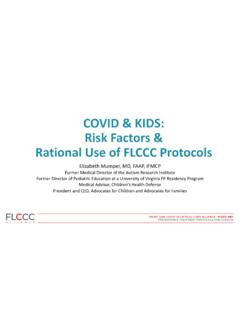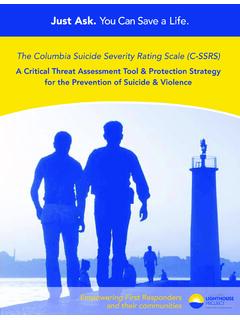Transcription of What Corrections Professionals Can Do to Prevent Suicide
1 What Corrections Professionals Can Do to Prevent Suicide The Role of Corrections Professionals in Preventing Suicide Inmates and Suicide Risk Recognizing the Warning Signs Responding to the Warning Signs Suicide Prevention in Correctional Facilities Resources Resources for Corrections Professionals General Resources on Suicide and Suicide Prevention References It had been a rough night at the Garfield jail. At about midnight, a drunk and distraught middle-aged man was booked for second degree sexual assault after groping a college student at a bar. He kept repeating that he had never been arrested before and asking if his name would be in the newspapers. While at first agitated, he eventually became morose and visibly depressed. After being booked, he was taken to a cell. Ten minutes later he was discovered hanging from the cell door with a bed sheet around his neck.
2 The sheet was wound so tightly that an officer had to run to a squad car for a chain cutter. Paramedics from the adjoining firehouse were called and unsuccessfully tried to resuscitate the prisoner. The next day, while discussing the incident, one of the arresting officers mentioned that the prisoner had said something about have to kill myself while being driven to the police station. The Role of Corrections Professionals in Preventing Suicide Suicide is the leading cause of death in American jails (Hayes and Rowen, 1988) and the third leading cause of death in American prisons (Bureau of Justice Statistics, 1998). While the Suicide rate in state prisons exceeds that for the general population, it is the smaller facilities in which prisoners are at extremely high risk. The Suicide rate for local jails is about four times that of the nation as a whole. And the Suicide rate for jails of 100 beds and fewer is about ten times that of the nation as a whole (Mumola, 2005; Tartaro and Ruddell, 2006).
3 Most inmate suicides are by hanging, which can result in death in five or six minutes. Brain death can occur in four minutes (Hayes, 1995). Inmates have died after hanging themselves from clothing hooks, shower knobs, cell doors, sinks, ventilation grates, windows, and smoke detectors (Hayes, 2007). Intake screening to identify inmates at risk for Suicide should be a standard procedure in all correctional facilities. All facilities should be equipped with Suicide resistant cells which deprive the inmate of, for example, bed sheets and projections on which to tie them (and thus the potential for hanging). However, intake screening is an imperfect tool. An inmate s risk for Suicide can fluctuate over the course of his or her incarceration. And while Suicide resistant cells can Prevent suicides, prisoners have shown an unfortunate ingenuity in using what is at hand to do themselves harm.
4 Thus, it is critical that correctional staff be taught to recognize and respond to warning signs that an inmate may be at risk for Suicide . Suicide Prevention Resource Center 877-GET-SPRC (877-438-7772) Education Development Center, Inc. 55 Chapel Street, Newton, MA 02458-1060 1 of 6 Suicide Prevention Resource Center 877-GET-SPRC (877-438-7772) Education Development Center, Inc. 55 Chapel Street, Newton, MA 02458-1060 2 of 6 Inmates and Suicide Risk Research has helped us understand the factors associated with suicidal behavior. Sixty to ninety percent of suicides are associated with depression, substance abuse disorders, and other forms of mental illness (Goldsmith, Pellmar, Kleinman, & Bunney, 2002). The presence of more than one psychiatric diagnosis (or the co-occurrence of a psychiatric diagnosis and substance abuse) and affective disorders, particularly depression, are major risk factors for Suicide .
5 Half of those who die by Suicide are afflicted with major depression (Jacobs, Brewer, & Klein-Benheim, 1999). Prisons and jails contain large numbers of people with the types of mental health problems associated with elevated risk of Suicide . A study by the Bureau of Justice Statistics (James and Glaze, 2006) revealed that more than half of prison and jail inmates have mental health problems. Approximately three-quarters of inmates with mental health problems have a co-occurring substance abuse disorder. Substantial numbers of inmates have major depressive orders ( of those in local jails, of those in state prisons, and 16% of those in Federal prisons). Another Bureau of Justice Statistics study found that about 10% of those incarcerated in Federal or state prisons or local jails had reported at least one overnight stay in a mental institution prior to their arrest (Ditton, 1999).
6 An American Psychiatric Association review (2000) of the research literature concluded that 20% of prison and jail inmates are in need of psychiatric care and 5% are actively psychotic . Prevention Recognizing the Warning Signs The most effective way to Prevent suicides in correctional facilities involves the systematic efforts discussed under Responding below. These include Suicide screening at intake, the availability of Suicide resistant cells, and a protocol that should be followed when a prisoner is thought to be at imminent risk of Suicide . However, a critical component of these strategies is to ensure that all correctional staff including guards, health care providers, and mental health Professionals understand how to recognize and respond to the warning signs that an inmate may be at imminent risk of trying to harm him or herself. These warning signs include the following: Verbal warnings.
7 People who are considering killing themselves often talk about their plans (or will talk about these plans if questioned). Such warning signs can include direct verbal cues, such as I wish I were dead, as well as indirect cues, such as My family would be better off if I didn t exist. A prisoner who threatens Suicide , admits that he or she thought about Suicide , or admits having planned how he or she could take his or her life should be taken seriously. Such statements should not be discounted even if the prisoner is intoxicated (given the relationship between Suicide and substance abuse disorders). Staff should also pay attention to similar thoughts or statements expressed in letters, poems, or other writings that may come to their attention. Depression. Although most people suffering from clinical depression do not kill themselves, a significant proportion of people who die by Suicide are clinically depressed.
8 The Suicide rate of people with major depression is eight times that of the general population (Jacobs, Brewer, & Klein-Benheim, 1999). Psychosis. Any signs of psychosis, such as talking to oneself, claiming to hear voices, or suffering hallucinations, should also be taken as a sign that the prisoner may be at risk (WHO, 2000; Hayes, 1995). Staff should be especially alert if prisoners have stopped taking anti-psychotic or anti-depressive medication. Reaction to incarceration. Many suicides in jails occur during the first 24 hours of detention. Many occur when an inmate is under the effect of alcohol or drugs. Young adults arrested for nonviolent offenses such as alcohol or drugs - are often at elevated risk of Suicide . They can be afraid of jail, embarrassed by their situation, and afraid of reaction of their family and friends to their arrest (Hayes, 1995). Suicide Prevention Resource Center 877-GET-SPRC (877-438-7772) Education Development Center, Inc.
9 55 Chapel Street, Newton, MA 02458-1060 3 of 6 One of the reasons that jails (and especially small jails) have higher Suicide rates than larger facilities is that they are the gateway into the justice system for most prisoners and the setting for their initial confrontation with their situation. Many of these prisoners are still on drugs or alcohol (or withdrawing from drugs or alcohol), may lack access to any medication they take, and may be faced with a great deal of guilt about their crime and afraid of the public and familial humiliation that may lie ahead. In addition, small jails often lack the mental health Professionals , Suicide -resistant cells, and level of staffing needed for consistent observation of prisoners (Tartaro and Ruddell, 2006). Current precipitating events. In addition to arrest and detention, there are other events that can precipitate a Suicide attempt, including receiving bad news from home ( marital problems or death or illness), conflict with other inmates, legal setbacks, withdrawal from drugs, and the tension caused by court hearings or sentencing (Hayes 1995).
10 Sexual coercion or even the threat of such coercion can also elevate an inmate s risk of Suicide (Struckman-Johnson, Struckman-Johnson, Rucker, et al., 1996). Responding to the Warning Signs Correctional personnel should not be afraid to ask an inmate if he or she has considered Suicide or other self-destructive acts. Asking someone if he or she has thought about Suicide will NOT increase the risk of Suicide . Correctional staff may want to be very direct and simply ask the question Are you thinking about killing yourself? It is very possible that an answer much less an honest answer will not be forthcoming, given the tension that can exist between inmates and correctional staff and the unwillingness of prisoners to open up about issues that they may consider to be signs of weakness. Any suspicion that a prisoner may be actively at risk of Suicide should be communicated to a mental health professional.








